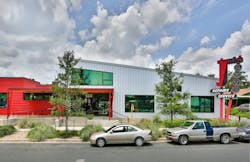SHOP STATS: Juke Auto Location: Austin, Texas Operator: Juke and Jonna Ball Average Monthly Car Count: 640 Staff Size: 23 Shop Size: 10,000 square feet Annual Revenue: $3.7 million
You know the saying, “Never judge a book by its cover,” but when it comes to a business—it’s the opposite for customers. Nowadays, a business’s aesthetic is what gets them in the door. It’s all about creating an attractive atmosphere that’s all around pleasing to a customer while they’re waiting for their vehicle to be serviced.
“It’s about having good curb appeal that will draw clients in,” Bhavana Bhimavarapu, a lead designer at Martha O’Hara Interiors in Minneapolis, Minn., says. “It’s a reflection of your business.”
When Juke Ball, owner of Juke Automotive in Austin, Texas, was building his new 10,000-square-foot shop in 2015 for his staff of 23, he wanted to make his shop standout from the rest, and it came down to knowing his customers.
“Austin is a progressive city,” Ball says. “People want things done in new ways and want something that’s better than usual.”
And it’s not just about appealing to sight, but other senses, too. Keeping this in mind, Ball was able to go from $1.9 million to $2.6 million when he opened his new shop because of its strategic curb appeal. Ball’s shop now sits at an annual revenue of $3.7 million with a $500 ARO and 160 monthly car count.
With the help of Bhimavarapu and Ball, here’s some tips on how to make your business more attractive to customers’ senses.
Sight
How a business looks is important. Bhimavarapu says it’s very important that your shop not only reflects what goes on inside, but the people there, too. It all starts with your presentation.
Bhimavarapu says you can create visual interest, but it doesn’t have to be just with color; you can add texture for visual interest; whether that means adding wallpaper to give the walls a little texture or your building itself as a sculpted work of art, adding texture is key.
With a funky architecture—making it look more like an art museum than an auto repair shop—and a pop of color on the exterior, Ball knew the shop would stand out.
“What I wanted was for it to really pop,” Ball says. “I wanted people to recognize the building from advertising and say, ‘Oh yeah, I recognize that place.’”
Your signage is also a reflection of your business. Too much signage, the shop seems chaotic and overwhelming. But not enough, and you could leave customers confused.
“How you display logos outside creates a huge difference,” Bhimavarapu says.
Before, Juke’s customers would get confused as to where the lobby entrance was. To ease confusion, he put up a funky 1950s sign pointing to the front door.
For new customers, it can take a while to build up trust with a new shop. To give customers an insight of the shop, Bhimavarapu suggests displaying a couple of customer reviews. Even better, Ball has a whole folder in the waiting room with the words “Our Customers Love Us” labeled on the front. In this folder holds every thank you card the shop has received for when customers are feeling apprehensive. It not only helps put customers at ease knowing they are in good hands, Ball says he wanted to show that the shop appreciates its customers, too.
“It’s like an intangible Yelp review,” Ball says. “Someone looking at one of those is like getting 10, five-star reviews.”
The Psychology Behind Sight
—
Ninety-three percent of purchasing judgements are made on visual perceptions and 80 percent of consumers think color increases brand recognition, according to information gathered from Colorfast.
Smell
When it comes to smell, less is more. You don’t want your shop to smell like garbage, or overpowered with a perfume-like aroma; meet in the middle. Bhimavarapu says to add an essential oil diffuser—a device that disperses essential oils into their air—even a plant or two, for a light, natural smell. For Ball, he took all-natural to the next level. Outside of his shop, he planted red oak trees, cacti plants and modern prairie grass along the street view of the shop. Because they are in Texas, Ball wanted to plant greenery that didn’t need to be watered often. His most prized plant, however? Texas green sage, which helped Ball reach his goal of adding softer elements and a nice, natural smell.
“It blooms multiple times per year and smells amazing when you walk in the door,” Ball says.
The Psychology Behind Smell
Smell is closely linked to memory. According to Psychology Today, a recent study found evidence to suggest that memories triggered by a smell (like the scent of a rose) were accompanied by greater activity in certain areas of the brain.
Touch
When a customer is sitting at your shop for a couple of hours, it’s important to make them feel comfortable and calm. In the waiting area, adding softer elements will make it feel more like home. Bhimavarapu says the materials you use really make a difference, whether its a comfy, leather couch, a cozy throw, or a fuzzy pillow, adding in softer elements will make your space feel like home.
And comfort also comes down to the type of seating you offer at your shop. Not everyone may want to sit and lounge around; some customers bring their laptops to get some work done. Bhimavarapu suggests having high-top, low-top, and lounge seating so customers can have options. In his shop, Ball offers a variety of chairs mixed with other chairs to handle lots of people; some comfy chairs for customers looking to relax, chairs with counter space to work, and smaller chairs available just in case.
The Psychology Behind Touch
—
According to a study from the University of Sam Ratulangi, Manando, one of the biggest influences for a customer choosing a movie theater to attend is comfortability and seating.
Hearing
When someone thinks of an auto repair shop, the sounds of clanking, drilling, and metal-on-metal may come to mind. But it doesn’t have to be this way. While customers wait for their vehicles, it’s important to provide a peaceful space to unwind or where customers can get some work done. Typically, shops can provide some background music on a surround-sound system. It’s important to note, however, that the music doesn’t overpower the space.
“It needs to be soft and subtle, something that doesn’t bother customers,” Bhimavarapu says.
Unlike a lot of repair shops, Ball’s waiting room is TV-free. He wanted a calm environment for his customers to sit back and relax without any disturbances.
The Psychology Behind Sound
—
According to the study “Music Congruity Effects on Product Memory, Perception, and Choice,” playing different types of background music can influence shopping behavior. Research suggests there seems to be some qualities of music that can influence buying behavior in a retail environment: tempo, pitch, volume and genre.
Taste
Who doesn’t love a good cup of coffee and treats to snack on (especially when customers have to wait a couple hours for their car to be repaired). Therefore, it’s important that your customer waiting room has some sort of refreshments to keep customers occupied and satisfied, making their experience more enjoyable. The one thing to stay away from though is adding a vending machine.
“I would never put in a vending machine,” Ball says. “It is way too impersonal and would send a message of trying to nickel and dime people.”
Ball makes sure to provide coffee and bottled water for his waiting customers, and his next project includes putting in a snack bar filled with treats from local businesses, like snack bars, a fruit tray, kid snacks, even a little kombucha (a trendy, fermented tea that’s all the rave nowadays).
The Psychology Behind Taste
—
Amenities are important for the customer experience, and a J.D. Power study found free food and beverages were the most popular amenities, with 60 percent of customers saying they “definitely will” return to a business where free snacks were offered.

